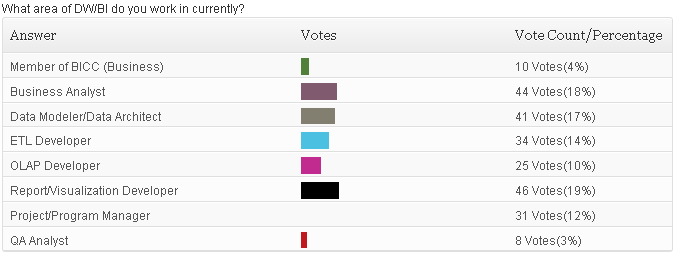If you had to build your BI Dream Team, who would be the players? Your first instinct might be to go the ultra-experienced route, filling the team with seasoned veterans bringing their wealth of knowledge to the company and letting them drive to the BI Promised Land. To be honest, that was my thought… bring in the most experienced people with the brightest BI minds and that can only make the BI solution that much better, right?
If you had to build your BI Dream Team, who would be the players? Your first instinct might be to go the ultra-experienced route, filling the team with seasoned veterans bringing their wealth of knowledge to the company and letting them drive to the BI Promised Land. To be honest, that was my thought… bring in the most experienced people with the brightest BI minds and that can only make the BI solution that much better, right?
I was marching down this path, within a budget or course, until I had a conversation with Dallas Marks over lunch a couple of months ago. He talked about building a BI team and compared it to making beef stew. I scratched my head and pondered this parable… and it started to make sense.
While a good BI Team does have a sprinkling of veterans, there is a need for mid-level team members as well as “newbies”. When you make beef stew, you don’t fill a pot with 4 pounds of filet minion, you’ve got to have celery, potatoes and onions as well as a good beef stock and some seasonings to get a quality beef stew.
Where Experience Counts
The first piece that needs to be in place is the Business Intelligence Architect. This person oversees all aspects of the solution from the requirements gathering to the training, and preferably they have experience in many, if not all, of these areas so they can act as a mentor to the entry-level and mid-level employees. The BI Architect needs a few implementations under their belts so they can react to and anticipate curves in the road as the project goes along.
The second area where some expertise is needed is in the data modeling and ETL development. These areas have to be executed near flawlessly for the other pieces of the solution to fall in to place. These are areas where you can augment the team with entry and mid-level employees, but they need experience mentors who are willing to teach them the skills needed to be successful.
As you move further towards the users, with cubes, reports and dashboards you have have the mid-level people more involved because this process may be more iterative and there can be more room for “error” and the developer and the user go back and forth on features and aspects of the consumables. Reporting in general is a good place to start in BI, if you have a good mentor in place, and once they “master” the art of reporting and visualization they can start to move backwards in the process and learn cubing, ETL programming and data modeling.
Mentoring
I mentioned mentoring a couple of times already, and I am a staunch supporter of the mentoring process. The first few years I had some good managers, but didn’t really get a good mentor until a few years in to my career. My early managers taught me more about business in general and dealing with users, but they did but me on the right path by exposing me to Ralph Kimball in the form of sending me to one of his seminars on the Data Warehouse Life Cycle. I was also given the opportunity to learn on my own through trial and error as BI tools were loaded on the my computer and I was asked to produce. Today, I value my mentor a great deal and even though I consider myself established I still ask question and seek advice when I’m considering a problem I’ve never faced. Finding a great mentor can be as challenging as finding the right job opportunities, but once you find them I suggest you hold on to them.
BI Career Survey
I conducted an informal BI Career Survey on this website to see how others got in to data warehousing and business intelligence and thought I would share some of the results here for those who may be looking on the best route to break in to the field. the survey had a relatively small sample size, but I think the results still have some value.
Of the 95 people who took the survey they broke down as followed: (not all respondents answered all the questions)
- 80% Male — 20% Female
- 77% working within IT — 23% working in a line of business or finance department
- BI Certifications
- 61% do not hold a BI specific certification
- 23% had a software specific certification
- 9% had a Microsoft Certification
- 5% held a CBIP from TDWI
One question I found interesting was “How they came to work in the BI/DW area and it was nearly evenly split with 46% starting as an entry-level employee while 52% transferred from a department (or within the IT department). The fact that 52% transferred in supports my thought that while there are distinct differences between a traditional IT workers skill set and a BI/DW workers skill set, there is a good amount of cross over and the right person can make that transition.
The people who took the survey also came from a very good mix of disciplines within BI as you can see. (Respondents were able to mark multiple areas of specialty.)
And lastly, I asked for each respondent to share some words of wisdom on how to get in to BI/DW and here are a few of the best ones.
“Technical skills only get you so far, business skills make a big difference.”
“Read Kimball and Inmon and start with Data Warehouse Modelling.”
“Learn the methodology; the software can vary. Have LOTS of patience.”
“It’s really rewarding yet challenging. Develop a solid understanding of the fundamentals.”
“Get into the community, there are a ton of smart people to learn from that freely give.”
“Get as broad a knowledge base as possible. Don’t tie your career to any one technology.”
“For technically skilled people: Try to start entry-level at a specialized IT consulting firm so you can learn all the aspects whilst working on various BI projects and see what you like.”
“Don’t become just a tool specialist; develop an understanding of the fundamentals and never forget SQL.”
“1. Study, study, study. 2. Learn excellent communications skills, you will need them.”
I hope this help shed some light on not only building a BI Team, but also getting starting with your career in BI. If you still have question, please post a comment and I will do my best to answer them, or I’m sure other BI professionals will share their thoughts as well.







